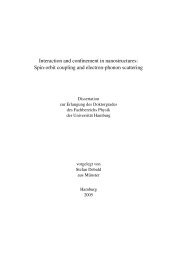Measuring the Electron Beam Energy in a Magnetic Bunch ... - DESY
Measuring the Electron Beam Energy in a Magnetic Bunch ... - DESY
Measuring the Electron Beam Energy in a Magnetic Bunch ... - DESY
Create successful ePaper yourself
Turn your PDF publications into a flip-book with our unique Google optimized e-Paper software.
up with and <strong>the</strong>n <strong>in</strong>teract with <strong>the</strong> electron bunch, giv<strong>in</strong>g it an energy spread which is<br />
correlated along <strong>the</strong> bunch. For an rms bunch length, σ z , dipole length, L B and dipole<br />
bend radius, R, <strong>the</strong> CSR-<strong>in</strong>duced rms relative energy spread per dipole for a Gaussian<br />
bunch under steady-state conditions is<br />
Nre<br />
LB<br />
Δ ECSR<br />
≈ 0.22<br />
(2.3.4)<br />
2 / 3 4 / 3<br />
γR<br />
σ<br />
z<br />
Where N is <strong>the</strong> number of electrons, r e is <strong>the</strong> classical electron radius and gamma is <strong>the</strong><br />
Lorentz energy factor [15]. S<strong>in</strong>ce <strong>the</strong> bunch length is shorter after each bend, <strong>the</strong> local<br />
energy spread generated <strong>in</strong> <strong>the</strong> last bend of <strong>the</strong> chicane will be <strong>the</strong> largest.<br />
Aside from <strong>the</strong> <strong>in</strong>crease <strong>in</strong> emittance, bunch compressors can also cause<br />
someth<strong>in</strong>g called a micro-bunch<strong>in</strong>g <strong>in</strong>stability when a density modulation created by <strong>the</strong><br />
impedance of geometric wakefields, longitud<strong>in</strong>al space-charge, or CSR get caught <strong>in</strong> a<br />
feedback loop <strong>in</strong> which <strong>the</strong>se energy modulations are coupled <strong>in</strong>to density modulations<br />
via <strong>the</strong> momentum compaction of <strong>the</strong> chicane. For example, <strong>the</strong> CSR creates an energy<br />
modulation of <strong>the</strong> bunch and <strong>the</strong> dispersion chops <strong>the</strong> beam up <strong>in</strong>to slices with lengths<br />
that are comparable to <strong>the</strong> coherent synchrotron radiation wavelengths. These microbunches<br />
<strong>the</strong>n <strong>in</strong>teract with one ano<strong>the</strong>r, experienc<strong>in</strong>g resonant oscillatory motion that can<br />
break <strong>the</strong> macro-beam apart. Although it was <strong>in</strong>itially suspected that CSR would be <strong>the</strong><br />
primary driver of <strong>the</strong> microbunch<strong>in</strong>g <strong>in</strong>stability, <strong>the</strong> longitud<strong>in</strong>al space-charge effects <strong>in</strong><br />
<strong>the</strong> <strong>in</strong>jector are now <strong>the</strong> primary focus of concern. The microbunch<strong>in</strong>g <strong>in</strong>stability can be<br />
avoided by <strong>in</strong>creas<strong>in</strong>g <strong>the</strong> residual energy spread of <strong>the</strong> bunch with a laser heater that<br />
imposes a periodic energy modulation over <strong>the</strong> bunch and <strong>the</strong>n smears it out<br />
longitud<strong>in</strong>ally via dispersion [16].<br />
At FLASH, a s<strong>in</strong>gle chicane is used as <strong>the</strong> first bunch compressor and a<br />
symmetric double-chicane is used as <strong>the</strong> second bunch compressor (Fig. 2.3.4). The<br />
microbunch<strong>in</strong>g <strong>in</strong>stability is more likely <strong>in</strong> <strong>the</strong> second chicane, due to <strong>the</strong> added bend<strong>in</strong>g<br />
of <strong>the</strong> double-chicane design and <strong>the</strong> higher energy of <strong>the</strong> beam [13]. In general, <strong>the</strong> ga<strong>in</strong><br />
of <strong>the</strong> <strong>in</strong>stability <strong>in</strong>creases with <strong>the</strong> <strong>in</strong>verse of <strong>the</strong> characteristic wavelength of <strong>the</strong><br />
modulation squared. It is cut off for wavelengths that are shorter than R 56 *C*δ. For <strong>the</strong><br />
first bunch compressor, R 56 , C and δ are larger than for <strong>the</strong> second bunch compressor and<br />
so <strong>the</strong> cut-off occurs at longer wavelengths, mak<strong>in</strong>g <strong>the</strong> microbunch<strong>in</strong>g less effective.<br />
With careful balanc<strong>in</strong>g of CSR and o<strong>the</strong>r effects, this can be avoided and <strong>the</strong> second<br />
chicane can be used to compensate for CSR-based emittance growth generated <strong>in</strong> <strong>the</strong><br />
upstream bunch compressor [17].<br />
16

















